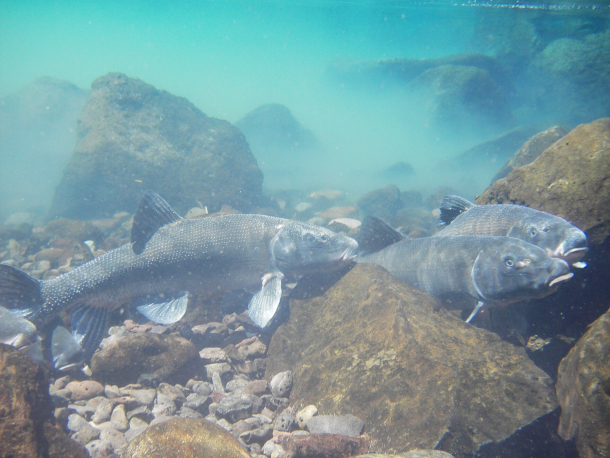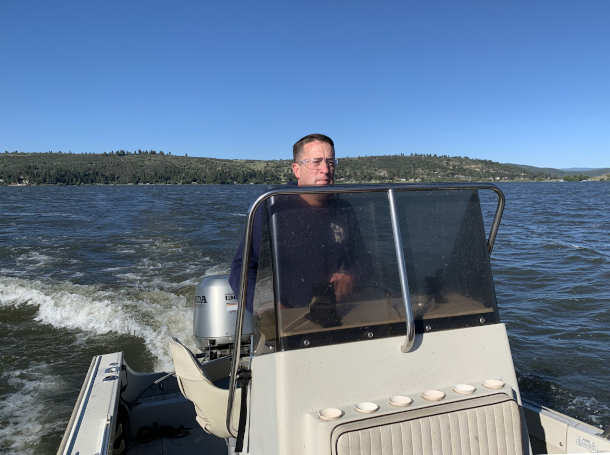C’waam And Koptu: The Fish at the Center of the Klamath Basin’s Water Crisis
Air Date: Week of October 22, 2021

C’waam, also known as Lost River suckers congregating to spawn on Sucker Springs in Upper Klamath Lake, Oregon. (Photo: Brian Hayes, USGS-Klamath Falls Field Station, public domain)
In the drought-stricken Klamath Basin along the California-Oregon border, water is a precious resource. Who gets that water hinges, in large part, on two endemic species of fish that make their home there and nowhere else in the world. Jefferson Public Radio reporter Erik Neumann reports.
Transcript
BASCOMB: In the drought-stricken Klamath Basin along the California-Oregon border, water is a precious resource. Who gets that water hinges, in large part, on two endemic species of fish that make their home on the Klamath and nowhere else in the world. Jefferson Public Radio reporter Erik Neumann has the story.
[BOAT SOUNDS]
NEUMANN: Biologist Alex Gonyaw aims his Boston Whaler up the eastern shore of Upper Klamath Lake. He’s showing off what, he says, used to be abundant habitat for juvenile fish.
GONYAW: It’s a mosaic of cattails and willows and tulles, or bullrushes.
NEUMANN: At almost 30 miles long, Upper Klamath Lake is the home to several types of fish that only live here.
GONYAW: So, the more hiding places for juvenile creatures the better they generally tend to do.
NEUMANN: Two of them are called C’waam and Koptu in the traditional Klamath language or in English the Lost River and shortnose sucker. They have a stubby face and wide lips and can live to be 50 years old.
GONYAW: They’re an endemic species. It's only found here, nowhere else in the universe and due to their sort of near extinction level status, they are becoming something of a figurehead in the water crisis here.
NEUMANN: In recent years, the juvenile fish have been dying, causing the overall population to crash. Five years ago, when Gonyaw started working for the tribes, there were about 20,000 shortnose suckers in the lake. Estimates today are just 3,400. The Lost River sucker is disappearing at a similar rate. Exactly why these fish are dying is unclear, but biologists believe it’s because of poor water quality and habitat loss that’s impacted by low water in the lake. Those factors make their future grim.
GONYAW: There's a catastrophic event likely in the next few years.
NEUMANN: In this extremely dry year in the Klamath Basin, much of the debate over who gets water depends on these fish. Water flowing out of the lake has been shut off to farmers who rely on the federally managed irrigation system. Even further down the Klamath River, threatened salmon are also getting the bare minimum. Besides being protected under the Endangered Species Act, the C’waam and Koptu are culturally important to the Klamath Tribes who say they’ve subsisted on them since time immemorial. At a recent rally in Klamath Falls, Tribal Chairman Don Gentry talked about how the Klamath people prayed for the fish to return after hard winters.
GENTRY: Those fish are so important. We wouldn’t be here likely without those fish that helped us survive.
NEUMANN: The declining fish numbers also illustrate a problem with the US government’s treaty. In 1864 the Klamath Tribes gave up around 20 million acres of land, in exchange for the right to hunt and fish. Gentry says those treaty rights don’t mean much if there are no fish to catch.

Klamath Tribes Senior Fish Biologist Alex Gonyaw boats across Upper Klamath Lake. Gonyaw is working to try to save the endangered C'waam and Koptu, or Lost River and shortnose suckers that live in the lake. (Photo: Erik Neumann / JPR)
GENTRY: What good is a treaty if you don't have the resources?
NEUMANN: He says the Endangered Species Act is meant to prevent species from going extinct. It doesn’t live up to the treaty responsibility of providing harvestable resources.
GENTRY: So we’re basically relegated to the ESA. And that’s.. that’s very minimal…It's not even working, you know, for us. But that's the thing that we have.
NEUMANN: The Klamath Tribes have senior water rights. But farmers in the basin are the other group that is linked to these fish. Mark Johnson represents irrigators with the group Klamath Water Users Association.
JOHNSON: Ultimately the farmers they want as they want all fish species to thrive is if the fish are doing well, everybody's doing well.
NEUMANN: For 15 years Johnson studied Lost River and shortnose suckers as a fish biologist with the US Geological Survey. One of the big frustrations from the irrigator standpoint, he says, is that water is prioritized to protect fish, but they’re still dying. But taking more water out of the lake would be gambling with the existence of a species.
JOHNSON: Yeah, I mean you are. But in terms of an extinction level event, I don't think that's actually going to happen. But on that trajectory we’re on right now, basically managing the lake the same way we have for over 20 years we haven't moved the needle. So, something has to change.
NEUMANN: There are no long-term solutions for saving the native fish populations. For the first time this year the Klamath Tribes are raising juvenile fish from eggs in a hatchery. When mature, they’ll be released in Upper Klamath Lake. This exceptionally dry year is shining a spotlight on the Klamath Basin and how there just isn’t enough water to go around. And with current climate trends, there’s little reason to think abundant water will be available any time soon.
Erik Neumann, JPR News.
BASCOMB: Reporter Erik Neumann’s story comes to us courtesy of Jefferson Public Radio.
Links
Find this story and more coverage of the Klamath water crisis on the JPR website
Watch a Klamath Tribes video about the fight to save their sacred C’waam and Koptu fish
Living on Earth wants to hear from you!
Living on Earth
62 Calef Highway, Suite 212
Lee, NH 03861
Telephone: 617-287-4121
E-mail: comments@loe.org
Newsletter [Click here]
Donate to Living on Earth!
Living on Earth is an independent media program and relies entirely on contributions from listeners and institutions supporting public service. Please donate now to preserve an independent environmental voice.
NewsletterLiving on Earth offers a weekly delivery of the show's rundown to your mailbox. Sign up for our newsletter today!
 Sailors For The Sea: Be the change you want to sea.
Sailors For The Sea: Be the change you want to sea.
 The Grantham Foundation for the Protection of the Environment: Committed to protecting and improving the health of the global environment.
The Grantham Foundation for the Protection of the Environment: Committed to protecting and improving the health of the global environment.
 Contribute to Living on Earth and receive, as our gift to you, an archival print of one of Mark Seth Lender's extraordinary wildlife photographs. Follow the link to see Mark's current collection of photographs.
Contribute to Living on Earth and receive, as our gift to you, an archival print of one of Mark Seth Lender's extraordinary wildlife photographs. Follow the link to see Mark's current collection of photographs.
 Buy a signed copy of Mark Seth Lender's book Smeagull the Seagull & support Living on Earth
Buy a signed copy of Mark Seth Lender's book Smeagull the Seagull & support Living on Earth

